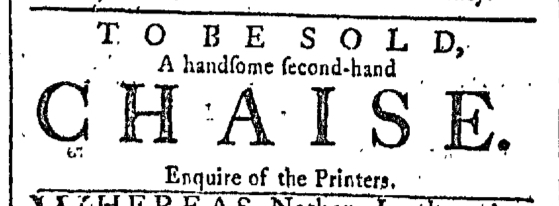What was advertised in a colonial American newspaper 250 years ago today?

“A handsome second-hand CHAISE.”
Colonists devised multiple ways to participate in the consumer revolution of the eighteenth century. Many purchased new good directly from merchants and shopkeepers, but others stole the items they desired or bought stolen goods at lower prices through an informal economy that made goods more accessible. Some also acquired secondhand goods at discounted prices that made them affordable. Advertisements for auctions, especially estate sales, frequently appeared in newspapers published throughout the colonies, presenting an array of goods to consumers looking for bargains. Other advertisements, however, announced the sale of particular used items, such as notice in the August 12, 1768, edition of the Providence Gazette that informed readers of a “handsome second-hand CHAISE” for sale. Interested parties were instructed to “Enquire of the Printers” for more information.
The chaise was one of the many sorts of wheeled carriages familiar to colonists. The Oxford English Dictionary indicates that the “exact application … varied from time to time,” but offers this general definition: “A light open carriage for one or two persons, often having a top or calash; those with four wheels resembling the phaeton, those with two the curricle; also loosely used for pleasure carts and light carriages generally.” In the absence of a more complete description in the advertisement, the flexibility of the term “chaise” encouraged prospective buyers to contact the printers for additional information.
Carriages of all sorts were markers of status, expensive to acquire and maintain. Opportunities to purchase secondhand carriages made them more affordable, but those with the means to purchase used carriages did not have to wait for private individuals to sell them. Some coachmakers, including Adino Paddock in Boston, incorporated sales of secondhand carriages into their marketing, selling those they received as trade-ins from customers who purchased new carriages. Regardless of who sold secondhand chaises and other sorts of carriages, their availability in the colonial marketplace indicates that they retained resale value after the initial sale. Colonists bought and sold used carriages long before the practice became a common aspect of the modern automobile industry.
